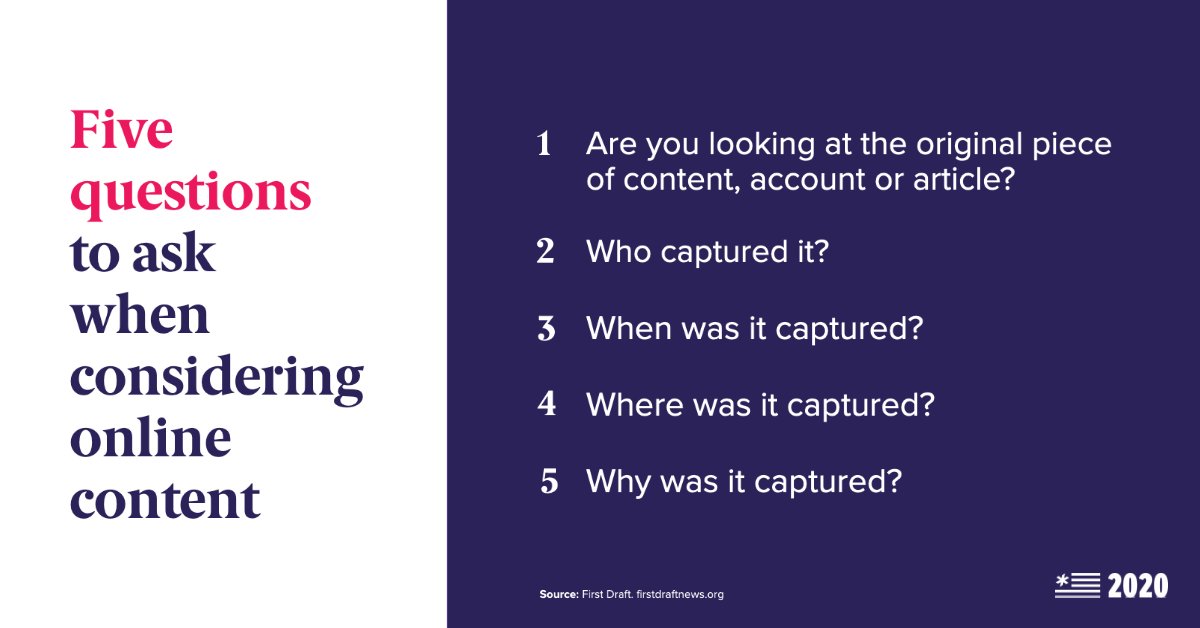
1/ With 6 days until #ElectionDay, let's talk about the disinformation and misinformation hitting our social media feeds this campaign cycle.
What's real? What's fake? And what's at stake for voters?
We turn to the experts: 🧵 bit.ly/2T7iTTx
What's real? What's fake? And what's at stake for voters?
We turn to the experts: 🧵 bit.ly/2T7iTTx
2/ First, what's the difference between disinformation and misinformation?
📌 Disinformation is the deliberate creation and sharing of information known to be false.
📌 Misinformation is the inadvertent sharing of false information. bit.ly/2T7iTTx
📌 Disinformation is the deliberate creation and sharing of information known to be false.
📌 Misinformation is the inadvertent sharing of false information. bit.ly/2T7iTTx

3/ Researcher @cward1e has identified seven types of problematic content in our information ecosystem.
Each type sits on a scale that loosely measures the intent to deceive — from satire or parody to intentionally fabricated content. bit.ly/2T7iTTx
Each type sits on a scale that loosely measures the intent to deceive — from satire or parody to intentionally fabricated content. bit.ly/2T7iTTx

4/ Let's be clear: Disinformation isn't new. Conspiracies have always had a way of finding new audiences.
But the deep anxiety and economic insecurity stemming from this pandemic coupled with a summer of racial protests and unrest have left us especially vulnerable.
But the deep anxiety and economic insecurity stemming from this pandemic coupled with a summer of racial protests and unrest have left us especially vulnerable.

5/ One conspiracy theory has been particularly prolific on social platforms: QAnon.
From October 2017 to June 2020, the Institute for Strategic Dialogue recorded
▪️ 69M+ tweets
▪️ 487K Facebook posts
▪️ 281K Instagram posts
mentioning QAnon-related hashtags and phrases.
From October 2017 to June 2020, the Institute for Strategic Dialogue recorded
▪️ 69M+ tweets
▪️ 487K Facebook posts
▪️ 281K Instagram posts
mentioning QAnon-related hashtags and phrases.

6/ So, what's QAnon?
▪️Conspiracy alleging an elite cabal of child-traffickers
▪️Began Oct. 2017 when someone identified as "Q" began posting cryptic msgs on 4chan
▪️"Q" claimed to have high-level security clearance + info about Trump's purported "battle against the deep state"
▪️Conspiracy alleging an elite cabal of child-traffickers
▪️Began Oct. 2017 when someone identified as "Q" began posting cryptic msgs on 4chan
▪️"Q" claimed to have high-level security clearance + info about Trump's purported "battle against the deep state"

7/ The QAnon conspiracy now spreads anti-vaccine, anti-5G, antisemitic and anti-migrant rhetoric, all in addition to the core belief that a consortium of elites are supposedly trafficking and sacrificing children. bit.ly/2T7iTTx 

8/ So how does this work on Instagram?
Earlier this summer, QAnon hijacked #SaveTheChildren, a hashtag related to real anti-human-trafficking causes.
This tactic of co-opting the hashtag helped amplify Q messaging. bit.ly/2T7iTTx
Earlier this summer, QAnon hijacked #SaveTheChildren, a hashtag related to real anti-human-trafficking causes.
This tactic of co-opting the hashtag helped amplify Q messaging. bit.ly/2T7iTTx

9/ Instagram posts are usually shared by people we trust: friends and family.
"If you trust the person who shared, you are more likely to trust the information."
Regardless of who shared a post, researchers suggest verifying where that social content actually originated.
"If you trust the person who shared, you are more likely to trust the information."
Regardless of who shared a post, researchers suggest verifying where that social content actually originated.

10/ We're all susceptible to falling for misinformation.
According @BouyguesLee, the more we use social media, the worse our news judgment becomes. Social media users are also not nearly as good at identifying fake news as they believe.
📝 reboot-foundation.org/is-there-a-fak…
According @BouyguesLee, the more we use social media, the worse our news judgment becomes. Social media users are also not nearly as good at identifying fake news as they believe.
📝 reboot-foundation.org/is-there-a-fak…

11/ What does all of this mean for the #2020Election?
In September, federal intelligence officials warned that foreign actors and cybercriminals are likely to spread disinformation regarding 2020 election results.
📝 ic3.gov/Media/Y2020/PS…
In September, federal intelligence officials warned that foreign actors and cybercriminals are likely to spread disinformation regarding 2020 election results.
📝 ic3.gov/Media/Y2020/PS…

12/ Election officials across the country have taken note.
Colorado is combating false information on social media by buying Google ads to counter misinformation on specific keywords and topics. nytimes.com/2020/10/20/us/…
Colorado is combating false information on social media by buying Google ads to counter misinformation on specific keywords and topics. nytimes.com/2020/10/20/us/…
13/ Social platforms have also taken some steps.
In early October, Facebook said it would remove any Facebook pages, groups and Instagram accounts representing QAnon — whether or not they contain violent content. bit.ly/2T7iTTx
In early October, Facebook said it would remove any Facebook pages, groups and Instagram accounts representing QAnon — whether or not they contain violent content. bit.ly/2T7iTTx

14/ But @BouyguesLee says responsibility also falls on citizens to learn better media literacy, use critical thinking and fact-check information more thoroughly.
"We need to be self-aware that we succumb to fake news." bit.ly/2T7iTTx
"We need to be self-aware that we succumb to fake news." bit.ly/2T7iTTx
15/ Remember: mis- and disinformation CAN mislead voters. And we're in a critical time for factual election information.
For more tips on how to identify mis- and disinformation on social platforms, ⬇️ dive into (and SHARE!) @marielpadilla_'s reporting. bit.ly/2T7iTTx
For more tips on how to identify mis- and disinformation on social platforms, ⬇️ dive into (and SHARE!) @marielpadilla_'s reporting. bit.ly/2T7iTTx
16/16 We've got one more #Election2020 🧵 coming up and it's just in time.
Stay tuned for our #19thExplains on voting. We're bringing you everything you need to know about Election Day and beyond. bit.ly/30Jnjoa
Stay tuned for our #19thExplains on voting. We're bringing you everything you need to know about Election Day and beyond. bit.ly/30Jnjoa
• • •
Missing some Tweet in this thread? You can try to
force a refresh






